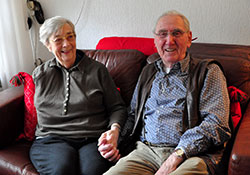Assisted living in Soest, the Netherlands

WHO/Malin Bring
While in their early 70’s, Truus van der Straaten and her husband Charles decided they could no longer manage their spacious home and garden, but they also felt too young for a nursing home. The Dutch system of assisted living apartments turned out to be both a pleasant and practical solution to their problem.
Today, ten years later, the couple is sitting on their living room sofa with the garden door open, thinking back to the time when they first came to live in their aanleunwoning. The literal translation of the Dutch word is “leaning dwellings,” which refers to independent apartments built next to or in the vicinity of a nursing home.
“Of course it took some getting used to, after all we had lived in our own house for 42 years when we decided to move here,” says Truus van der Straaten, for the time being with her right arm in a sling, because of a recently broken collarbone.
The couple’s flat is situated on the ground floor of a complex comprising 150 apartments, built next to the nursing home Mariënburg, which is run by the care organization Beweging 3.0 in the Dutch community of Soest. The flat consists of a living room with integrated kitchen, sleeping alcove and bathroom, and has a small garden with a terrace. For this, the van der Straatens pay approximately the same rent they would pay for a similar conventional apartment. For tenants with low incomes, the rent is subsidized.
The general trend in the Netherlands, as in many other western European countries, is that senior citizens prefer to stay in their own homes as long as possible, and decide for themselves which services they want (and can afford) to utilize. An assisted living apartment is a sort of “half-way house” between independent living and a nursing home. The tenants have the freedom and privacy of a conventional apartment, but the security and professional care of a nursing home right next door, if they should need it.
“We just have to press the alarm button and the caregivers are here in the blink of an eye. We experienced this when Truus fell and broke her collarbone two weeks ago,” says Charles van der Straaten. “So far we don’t use many of Mariënburg’s services,” adds his wife, “apart from cleaning help once a week, and the nurse who comes to check on my collarbone. But of course it’s a comfort to know that we can get more help if things should take a turn for the worse.”
The nursing home offers two hot meals a day, various degrees of professional care and the possibility to borrow aids like wheelchairs and special beds. It also organizes various social activities, explains Els Turk, team leader for the caregivers, both inside the nursing home and in the independent apartments.
“We have many married couples living here, and most of them want to stay in the apartments as long as possible. If one of the spouses becomes so ill that he or she has to move to the nursing home, the other one often chooses to remain in the apartment, so they can still be close to each other,” she says.
Truus van der Straaten looks out to her small garden and smiles: “It’s wonderful here. It’s so easy to get outside and sit in the sun for a while, which is terrific for someone like me, who is a poor walker.”
Her husband remarks that without doubt the assisted living apartments are popular with the tenants. “The other day one of our neighbours, who was 109 years old, passed away. She was living completely independently and did everything around the house herself, until the day she died,” he says.



